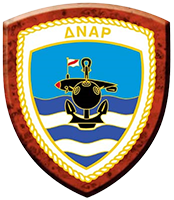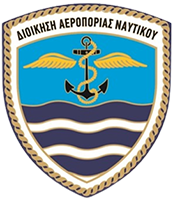Fleet Headquarters

Crest
The Hellenic Fleet H.Q crest depicts an Athenian trireme, the most known warship of Ancient Greece.
The moto «ΣΤΟΛΟΣ ΘΑΛΑΣΣΗ ΚΡΑΤΕΙΝ = A FLEET IS DESTINED TO RULE THE SEA», encompasses the significance that Herodotus credited to the power a nation gained through the possession of a vigorous warship fleet, furthermore, it’s the recognition of the Fleet’s primary task to rule the sea.
History
The Hellenic Fleet’s history dates back to 1828.
During the Kapodistrian era, in October 1829, the National Fleet was formed, under the command of Costantine Kanaris. It’s form and structure was correlated to the political and security needs of the Hellenic State.
The Hellenic Fleet H.Q, under its current form, is the result of the 1970 merger of the Cretan & Ionian Sea Command and The Aegean Command. In 1970, under the command of Rear Admiral Georgios Moralis, the Hellenic Fleet Command was established. Finally, in 1977, under the command of Vice Admiral Theodoros Deyannis, the Hellenic Fleet Command transformed to the Hellenic Fleet H.Q.
Mission
To ensure the organization, command, training, maintenance, safety, readiness and in general the ships and subordinate command preparedness for warf, as well as to plan and execute joint or not operations, within the frame of the Chief of the Hellenic National Defence General Staff & the Chief of the Hellenic Navy General Staff orders and directions, under the scope of the Fleet, part of it, or individual warships and its Subordinate Commands, undertaking the tasks deriving from the Hellenic Navy mission and the operational plans in force, both in times of peace and crisis, as well as in times of war”.
The surveillance of the Chief’s of the Hellenic National Defence General Staff maritime area of responsibility is the most important peacetime task for the Hellenic Fleet, not limited to it.
As part of its mission, the Hellenic Fleet undertakes, in cooperation or not with other Major Commands, additional tasks, the main ones of which are
- Naval presence,
- Protection of Greek sovereign rights (Continental shelf, EEZ, Greek-owned Shipping),
- Protection of sea lines of communication,
- Readiness to enforce and maintain maritime control,
- Response to acts of aggression,
- Projection of power from sea,
- Execution of operational plans.
Organization
The Hellenic Fleet Headquarters is based in Salamina Naval Station. The Chief of the Hellenic Fleet reports to the Chief of the Hellenic Navy General Staff under an Administrative Command relationship, and the Operational Command retained by the Chief of the Hellenic National Defence General Staff. The Fleet Headquarters is a Major Command of the Hellenic Armed Forces and is one of the three major military commands of the Navy. The other two are the Naval Training Command and the Naval Administration.
The Chief of the Hellenic Fleet Commands all Hellenic Fleet personnel. He has the responsibilities and authorities of a major command commander and exercises command and control of his forces from the Hellenic Fleet Maritime Operations Center.
The Deputy Chief of the Fleet is the Embarked Commander, evaluates the level of operational readiness and training of all Hellenic Fleet warships through the Directorate of Operational Evaluation which falls under his jurisdiction. Under the scope of the warships Commanding Officers support to their mission, the Directorate of Operational Evaluation provides high level combat training to the fleet’s warships.
The Chief of Staff coordinates the Hellenic Fleet Staff business, which is divided into five branches with responsibilities for operations, human resources, armament and electronic systems, propulsion and ship systems, and finance respectively.


























